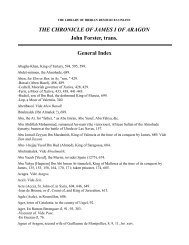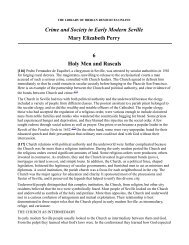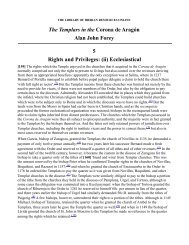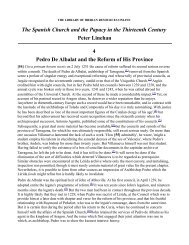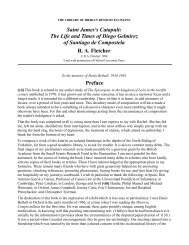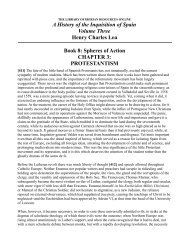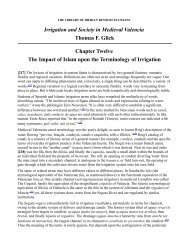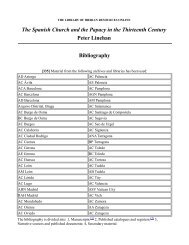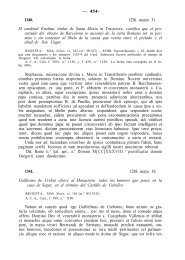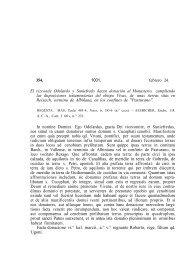Chapter 11 - The Library of Iberian Resources Online
Chapter 11 - The Library of Iberian Resources Online
Chapter 11 - The Library of Iberian Resources Online
You also want an ePaper? Increase the reach of your titles
YUMPU automatically turns print PDFs into web optimized ePapers that Google loves.
composition based on a cantiga tune was that <strong>of</strong> Hilarión Eslava (c. 1861 ?). [34] From the turn <strong>of</strong> the<br />
century to the early 1930s, there followed arrangements <strong>of</strong> selected Cantigas melodies by Luis Villalba<br />
(one [172] being that <strong>of</strong> the cantiga under discussion), Felipe Pedrell, and Tomás Bretón, [35] including<br />
transcriptions <strong>of</strong> various cantigas made by such renowned musicologists as PierreAubry , the Arabist<br />
Julián Ribera, Gregorio María Sunyol, and J.B. Trend. [36] Trend based most <strong>of</strong> his transcriptions on<br />
those <strong>of</strong> Aubry , reworking several <strong>of</strong> them. Thus, by the time Schindler collected "Rosa das rosas, "<br />
there was a goodly amount <strong>of</strong> interest in the Cantigas repertory, and this undoubtedly prompted Angles<br />
to undertake his monumental study. His transcription <strong>of</strong> the entire corpus was to become the basis for<br />
the present and continued resurgence <strong>of</strong> cantigas performances throughout the world. [37]<br />
Possible Textual and Melodic Antecedents<br />
Jacques Chailley pointed out Alfonso's literal paraphrase <strong>of</strong> "Rose des roses et fleurs des fleurs " from<br />
the sixth verse <strong>of</strong> Gautier de Coinci's Chanson á la Vierge, "Quant ces floretes florir voi." 38] It is likely<br />
that Alfonso was inspired by this verse, which he developed into a full-fledged song in praise <strong>of</strong> the<br />
Virgin and which, together with Prologue B, cantiga de loor 1, and the Petiçon (cantiga 401),<br />
constitutes the strongest grounds for attributing his authorship to these particular examples.<br />
In a recent article I alluded to the ninth-century sequence " Victimae paschali laudes " (Example <strong>11</strong>-3c)<br />
as a possible source or inspiration for "Rosa das rosas" (Example <strong>11</strong>-3a, taken from the Toledo codex,<br />
dating from around 1257), whose melodic incipit it closely resembles. [39] For the Example <strong>11</strong>-3b<br />
(taken from Escorial B.1 2), the Argentine musicologist Josué T. Wilkes (1942) found additional<br />
melodic similarities in the antiphons "Magnum haereditatis mysterium " (Example <strong>11</strong>-3f) and "In<br />
patientia vestra " (Example <strong>11</strong>-3e), [40] to which I add the antiphon " Juste et pie vivamus " (Example<br />
<strong>11</strong>-3d). <strong>The</strong>se can be seen in the Liber usualis. Even the melodic incipit <strong>of</strong> the thirteenth-century<br />
sequence, " Stabat Mater" (Example <strong>11</strong>-3g), attributed to the Franciscan Jacopone da Todi (c. 1228-<br />
1306) and which also may have been inspired by the earlier ninth-century sequence, is much closer to<br />
the Escorial version <strong>of</strong> "Rosa das rosas" which dates from around 1281.<br />
With regard to the form <strong>of</strong> the cantiga, Anglés placed "Rosa das rosas" in the category <strong>of</strong> virelais and<br />
mentioned that it was similar in structure to cantiga 64, " Quen mui benquiser." In his analysis <strong>of</strong> the<br />
refrain and stanzas, he counted, according to the rules <strong>of</strong> versification, an average <strong>of</strong> ten syllables per<br />
line <strong>of</strong> verse, save the initial one. Yet a careful reading <strong>of</strong> the second [173] line <strong>of</strong> refrain bears out the<br />
fact that it contains eleven syllables. Moreover, Anglés used Greek letter to designate the corresponding<br />
melody phrase for each verse. [41]<br />
Rhyme Scheme Melody<br />
Rosa das rosas e Fror das frores A 9 a<br />
Dona das donas, Sennor das sennores A <strong>11</strong> ß<br />
Rosa de beldad' e de parecer b 10 g<br />
e Fror d'alegria e de prazer b 10 g<br />
Dona en mui piadosa seer, b 10 d<br />
Sennor en toller coitas e doores a 10 ß




